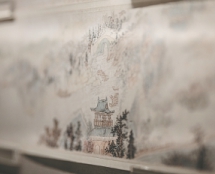

Unity with nature
Learning from the rules of the universe and achieving a state of harmony between humans and nature were at the heart of depictions of natural landscapes and living things in classic Chinese painting. Through such works ancient painters and viewers sought spiritual freedom. And appreciating these paintings allow people a glimpse into the minds of artists and intellectuals of the past, and be lost in quiet contemplation of the ultimate relation between humans and the cosmos. Forests and Streams Resplendently Clear, a long-term exhibition at Tsinghua University Art Museum, addresses this fascinating and thought-provoking aspect of Chinese art. The exhibition, opened last year to mark Tsinghua University's 110th anniversary, gathers ink-color paintings from the collections of museums and private assemblies. The works are not only a celebration of the splendor of nature and the dynamics of living things-birds, flowers, fish and insects-but also open discussions about forming an ideal way of living, which, according to ancient intellectuals, should be leisurely and artistically enriched. The paintings show people surrounded by mountains and waters, or relaxing in carefully designed gardens, an artificial enactment of nature while enjoying cultural activities. By doing so, ancient Chinese believed they could realize a state of freedom and spiritual satisfaction, and a unity with the universe.
9 am-5 pm, closed on Mondays. Tsinghua University, Haidian district. 010-6278-1012.